As the COVID-19 pandemic continues to wreak havoc across the globe and the U.S., more and more Americans are facing food insecurity. Now more than ever, organizations like United Food Bank and other Feeding America members are critical to ensuring that no one goes to bed hungry — but they can’t do it alone. Please consider donating your time, talent, or treasure here, and together we can weather this crisis!
This blog post was written by Arizona State University graduate student Liz Broussard. In addition to studying Food Policy and Sustainability Leadership at ASU, Liz serves as a project coordinator at the National Center for Appropriate Technology (NCAT), where she supports the Mississippi Food Justice Collaborative, a network of organizations working to improve access to healthy food and transform Mississippi food systems.
This past December, I had the opportunity to fly across the country and join my classmates in Arizona for a Food and Farm Immersion course as part of ASU’s food policy and sustainability leadership program. On the second day of our trip, we visited the United Food Bank in Mesa, AZ, which stood out as pretty different from our other stops. There were no dairy cows, farm tractors, or acres of leafy greens. Instead, we arrived to a clean, spacious warehouse full of wooden palettes, cardboard boxes, colorful food packages, and smiling volunteers.
The United Food Bank distributes approximately 61,000 meals daily, and relies upon volunteer support to make that happen. While we were visiting, we had the opportunity to lend a hand, bag some meals for families, and hear from some of the volunteers and staff who keep the food bank running from day to day. It was obvious that they have a lot of experience coordinating volunteers, and they made the experience very fun, assigning unique roles to each of us and even playing techno dance music over the loudspeaker while we loaded grocery bags with rice, packaged chicken, cans of corn, mixed fruit, and more.
The concept of a food bank was actually first developed in Phoenix in the 1960s as a way to divert waste from an over-productive food supply and reuse it to meet an important need — feeding hungry people. Food banks came about as a response to that need, but decades later, we have still not solved the issue of hunger or food insecurity, and food banks have not done much to address its root causes. According to the USDA, “1 in 8 households in the United States had difficulty at some time during the year in providing enough food for all their members.” That percentage is even higher for African American, Native American, and Hispanic households. Eradicating hunger requires more than just feeding people — it requires challenging unjust systems that have resulted in people, especially people of color, not having access or being able to afford healthy food for their families.
“The root cause of hunger is poverty. So if we aren’t doing any work to address that, then we are not really solving hunger,” said Angie Rodgers, president and CEO of the Association of Arizona Food Banks. “The things that impact poverty are things like people’s ability to work, find jobs in rural communities, to access high quality education… We really need to address those things if we really want to address the demand in food banks.”
Angie spoke to us about the importance of policy and advocacy in anti-hunger work. According to Bread for the World, food banks and private charities provide only one out of every 20 bags of groceries that feed people who are hungry. That’s only a small slice of the pie. The federal government provides the rest through child nutrition and food assistance programs. Angie highlighted some of the important advocacy work she has been involved in recently to protect those federal government programs, including the Supplemental Nutrition Assistance Program (SNAP), which is a lifeline for millions of Americans. Some of the advocacy work she highlighted including opposing the SNAP Able-Bodied Adults Without Dependents (ABAWDS) Rule and opposing restrictions being made to broad-based categorical eligibility.
By the time we had to leave and load up the vans, I was really grateful for the opportunity to volunteer and pack food bags for families and to learn more about Angie’s work. I also couldn’t help but wonder: What if every volunteer, every person who led a food donation drive in their community or packed food bags at a food bank to the tune of techno dance music, also took some time to advocate for policies for fair wages, education, housing, or health care for the most vulnerable? What if communities had the knowledge and resources to grow and prepare healthy food for their families and neighbors? What would it take for us to build a world where food banks are a thing of the past?
On behalf of the entire ASU Food Policy and Sustainability cohort, I would like to extend our sincere appreciation to Angie and her staff for giving us the opportunity to volunteer and learn more about hunger in Arizona.
As we navigate these uncertain times it is more important than ever to have a robust network of food and agriculture policy leaders to make sensible and responsible decisions. Could you be one of those people? Learn more about answering this call by checking out the Food Policy and Sustainability Leadership Program at ASU!


